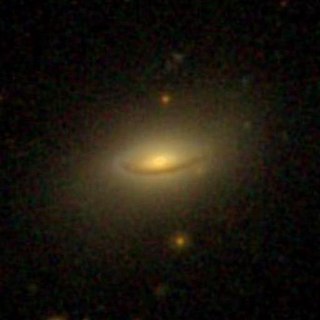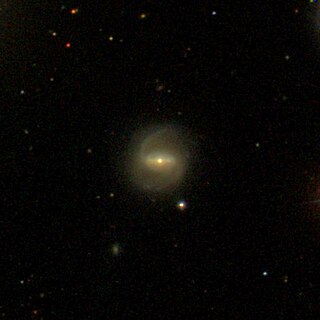Related Research Articles

NGC 2787 is a barred lenticular galaxy approximately 24 million light-years away in the northern constellation of Ursa Major. It was discovered on December 3, 1788 by German-born astronomer William Herschel. J. L. E. Dreyer described it as, "bright, pretty large, a little extended 90°, much brighter middle, mottled but not resolved, very small (faint) star involved to the southeast". The visible galaxy has an angular size of 2′.5 × 1′.5 and an apparent visual magnitude of 11.8.

NGC 4309 is a lenticular galaxy located about 55 million light-years away in the constellation Virgo. The galaxy was discovered by astronomer Christian Peters in 1881 and is a member of the Virgo Cluster.
The Pavo–Indus Supercluster is a neighboring supercluster located about 60–70 Mpc (196–228 Mly) away in the constellations of Pavo, Indus, and Telescopium. The supercluster contains three main clusters, Abell 3656, Abell 3698, and Abell 3742.

NGC 4323 is a lenticular or dwarf elliptical galaxy located about 52.5 million light-years away in the constellation Coma Berenices. The galaxy was discovered in 1882 by astronomer Wilhelm Tempel and is a member of the Virgo Cluster.

NGC 4203 is the New General Catalogue identifier for a lenticular galaxy in the northern constellation of Coma Berenices. It was discovered on March 20, 1787 by English astronomer William Herschel, and is situated 5.5° to the northwest of the 4th magnitude star Gamma Comae Berenices and can be viewed with a small telescope. The morphological classification of NGC 4203 is SAB0−, indicating that it has a lenticular form with tightly wound spiral arms and a weak bar structure at the nucleus.

Georges Meylan is a Swiss astronomer, born on July 31, 1950 in Lausanne, Switzerland. He was the director of the Laboratory of Astrophysics of the Swiss Federal Institute of Technology (EPFL) in Lausanne, Switzerland, and now a professor emeritus of astrophysics and cosmology at EPFL. He is still active in both research and teaching.

NGC 708 is an elliptical galaxy located 240 million light-years away in the constellation Andromeda and was discovered by astronomer William Herschel on September 21, 1786. It is classified as a cD galaxy and is the brightest member of Abell 262. NGC 708 is a weak FR I radio galaxy and is also classified as a type 2 Seyfert galaxy.

NGC 679 is an elliptical or a lenticular galaxy located 210 million light-years away in the constellation Andromeda. The galaxy was discovered by astronomer William Herschel on September 13, 1784 and is a member of Abell 262.

NGC 4065 is an elliptical galaxy located 300 million light-years away in the constellation Coma Berenices. The galaxy was discovered by astronomer William Herschel on April 27, 1785. It was then rediscovered by John Herschel on April 29, 1832 and was listed as NGC 4057. NGC 4065 is the brightest member of the NGC 4065 Group.

NGC 4074 is a peculiar lenticular galaxy located 310 million light-years away in the constellation Coma Berenices. It was discovered by astronomer William Herschel on April 27, 1785 and is a member of the NGC 4065 Group.

NGC 4076 is a spiral galaxy located 290 million light-years away in the constellation Coma Berenices. The galaxy was discovered by astronomer William Herschel on April 27, 1785 and is a member of the NGC 4065 Group.

NGC 4298 is a flocculent spiral galaxy located about 53 million light-years away in the constellation Coma Berenices. The galaxy was discovered by astronomer William Herschel on April 8, 1784 and is a member of the Virgo Cluster.

NGC 4299 is a featureless spiral galaxy located about 55 million light-years away in the constellation Virgo. It was discovered by astronomer William Herschel on March 15, 1784 and is a member of the Virgo Cluster.

NGC 4306 is a dwarf barred lenticular galaxy located about 100 million light-years away in the constellation Virgo. The galaxy was discovered by astronomer Heinrich d'Arrest on April 16, 1865. Although considered to be a member of the Virgo Cluster, its high radial velocity and similar distance as NGC 4305 suggest that NGC 4306 is a background galaxy. NGC 4306 is a companion of NGC 4305 and appears to be interacting with it.

The Teacup galaxy, also known as the Teacup AGN or SDSS J1430+1339 is a low redshift type 2 quasar, showing an extended loop of ionized gas resembling a handle of a teacup, which was discovered by volunteers of the Galaxy Zoo project and labeled as a Voorwerpje.

NGC 4324 is a lenticular galaxy located about 85 million light-years away in the constellation Virgo. It was discovered by astronomer Heinrich d'Arrest on March 4, 1862. NGC 4324 has a stellar mass of 5.62 × 1010M☉, and a baryonic mass of 5.88 × 1010M☉. The galaxy's total mass is around 5.25 × 1011M☉. NGC 4324 is notable for having a ring of star formation surrounding its nucleus. It was considered a member of the Virgo II Groups until 1999, when its distance was recalculated and it was placed in the Virgo W Group.

NGC 4333 is a barred spiral galaxy with a ring structure located about 330 million light-years away in the constellation Virgo. It was discovered by astronomer William Herschel on April 13, 1784, who described it as "F, pS, R, bM, 2nd of 3". NGC 4333 is also classified as a LINER galaxy. Despite being listed in the Virgo Cluster catalog as VCC 637, it is not a member of the Virgo Cluster but instead a background galaxy.

NGC 1570, mistakenly called NGC 1571, is a faint galaxy located in the southern constellation Caelum, the chisel. It has a blue magnitude of 13.2, making it visible through a medium sized telescope. Based on a redshift of z = 0.014760, the object is estimated to be 198 million light years away from the Local Group. It appears to be receding with a heliocentric radial velocity of 4,392 km/s.
References
- 1 2 Gordon, David; Jacobs, Christopher; Beasley, Anthony; Peck, Alison; Gaume, Ralph; Charlot, Patrick; Fey, Alan; Ma, Chopo; Titov, Oleg; Boboltz, David (27 May 2016). "SSecond Epoch VLBA Calibrator Survey Observations: VCS-II". The Astronomical Journal. 151 (6): 154. Bibcode:2016AJ....151..154G. doi: 10.3847/0004-6256/151/6/154 . eISSN 1538-3881. PMC 6010998 . PMID 29937549.
- 1 2 Paturel, G.; Dubois, P.; Petit, C.; Woelfel, F. (2002). "Comparison LEDA/SIMBAD octobre 2002. Catalogue to be published in 2003". LEDA: 0. Bibcode:2002LEDA.........0P.
- 1 2 3 4 5 Dálya, G; Díaz, R; Bouchet, F R; Frei, Z; Jasche, J; Lavaux, G; Macas, R; Mukherjee, S; Pálfi, M; de Souza, R S; Wandelt, B D; Bilicki, M; Raffai, P (30 May 2022). "GLADE+:an extended galaxy catalogue for multi-messenger searches with advanced gravitational-wave detectors". Monthly Notices of the Royal Astronomical Society. 514 (1): 1403–1411. arXiv: 2110.06184 . Bibcode:2022MNRAS.514.1403D. doi:10.1093/mnras/stac1443. eISSN 1365-2966. ISSN 0035-8711.
- 1 2 3 4 Somboonpanyakul, Taweewat; McDonald, Michael; Lin, Henry W.; Stalder, Brian; Stark, Antony (16 August 2018). "The Clusters Hiding in Plain Sight (CHiPS) Survey: A First Discovery of a Massive Nearby Cluster around PKS 1353−341". The Astrophysical Journal. 863 (2): 122. arXiv: 1806.05676 . Bibcode:2018ApJ...863..122S. doi: 10.3847/1538-4357/aace55 . eISSN 1538-4357.
- ↑ Véron-Cetty, M.-P.; Véron, P. (July 2010). "A catalogue of quasars and active nuclei: 13th edition". Astronomy & Astrophysics. 518: A10. Bibcode:2010A&A...518A..10V. doi: 10.1051/0004-6361/201014188 . eISSN 1432-0746. ISSN 0004-6361.
- ↑ Flesch, Eric W. (2015). "The Half Million Quasars (HMQ) Catalogue". Publications of the Astronomical Society of Australia. 32. arXiv: 1502.06303 . Bibcode:2015PASA...32...10F. doi: 10.1017/pasa.2015.10 . eISSN 1448-6083. ISSN 1323-3580.
- 1 2 Véron-Cetty, M. -P.; Woltjer, L.; Staveley-Smith, L.; Ekers, R. D. (October 2000). "The nature of powerful compact radio galaxies". Astronomy and Astrophysics. 362: 426–434. Bibcode:2000A&A...362..426V. ISSN 0004-6361.
- 1 2 Massaro, E.; Maselli, A.; Leto, C.; Marchegiani, P.; Perri, M.; Giommi, P.; Piranomonte, S. (18 April 2015). "The 5th edition of the Roma-BZCAT. A short presentation". Astrophysics and Space Science. 357 (1): 75. arXiv: 1502.07755 . Bibcode:2015Ap&SS.357...75M. doi:10.1007/s10509-015-2254-2. eISSN 1572-946X. ISSN 0004-640X. S2CID 254255813.
- ↑ Skrutskie, M. F.; Cutri, R. M.; Stiening, R.; Weinberg, M. D.; Schneider, S.; Carpenter, J. M.; Beichman, C.; Capps, R.; Chester, T.; Elias, J.; Huchra, J.; Liebert, J.; Lonsdale, C.; Monet, D. G.; Price, S.; Seitzer, P.; Jarrett, T.; Kirkpatrick, J. D.; Gizis, J. E.; Howard, E.; Evans, T.; Fowler, J.; Fullmer, L.; Hurt, R.; Light, R.; Kopan, E. L.; Marsh, K. A.; McCallon, H. L.; Tam, R.; Van Dyk, S.; Wheelock, S. (February 2006). "The Two Micron All Sky Survey (2MASS)". The Astronomical Journal. 131 (2): 1163–1183. Bibcode:2006AJ....131.1163S. doi: 10.1086/498708 . eISSN 1538-3881. ISSN 0004-6256.
- ↑ Preston, R. A.; Morabito, D. D.; Williams, J. G.; Faulkner, J.; Jauncey, D. L.; Nicolson, G. (September 1985). "A VLBI survey at 2.29 GHz". The Astronomical Journal. 90: 1599. Bibcode:1985AJ.....90.1599P. doi: 10.1086/113869 . ISSN 0004-6256.
- ↑ Siebert, J.; Brinkmann, W.; Drinkwater, M. J.; Yuan, W.; Francis, P. J.; Peterson, B. A.; Webster, R. L. (November 1998). "X-ray properties of the Parkes sample of flat-spectrum radio sources: dust in radio-loud quasars?". Monthly Notices of the Royal Astronomical Society. 301 (1): 261–279. arXiv: astro-ph/9808065 . Bibcode:1998MNRAS.301..261S. doi: 10.1046/j.1365-8711.1998.02019.x . eISSN 1365-2966. ISSN 0035-8711.
- ↑ Arce, Nicole. "Dazzling Galaxy Cluster Hiding In Plain Sight In Milky Way Neighborhood". Tech Times. Retrieved July 26, 2018.